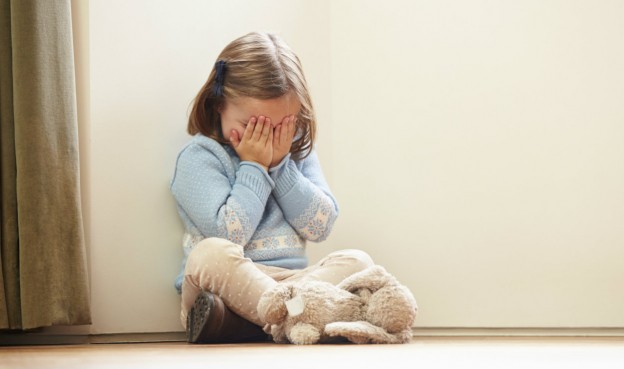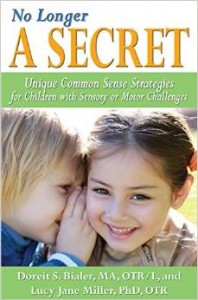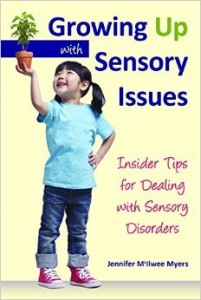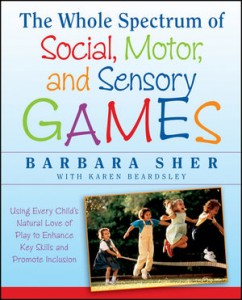
Products  -by Doreit S. Bialer, MA, OTR/L and Lucy Jane Miller, PhD, OTR
Parents will be extremely pleased to read they can help their children by using thoughtful strategies that do not involve expensive, technologically sophisticated equipment. No Longer A SECRET is filled with low-cost, low-tech strategies for kids with SPD. Dr. Miller even says, “The best tool you have to help a child with SPD is you!”
The authors suggest reading their book in consecutive order and not skipping around. And when I finished the last page I understood why. The authors took great pains to explain clearly, step-by-step, the many aspects of SPD- the subtypes, the symptoms, the solutions. As you read through the book, all this rather complex information on sensory issues falls into place. As a child with SPD usually does not fit into only one classification, you will “find” your child/student here and there in the book.
The use of short case studies so the reader can “meet” a child with the symptoms they are describing in that section is very effective. There are numerous tables that summarize content: symptoms, guidelines, differences between children with various challenges, activity suggestions, cost-effective sensory activities, etc.
After the first reading, the Table of Contents and the valuable Index indicating clearly the various figures and tables make it easy to locate the sections you want to reread.
Read complete review.
-by Doreit S. Bialer, MA, OTR/L and Lucy Jane Miller, PhD, OTR
Parents will be extremely pleased to read they can help their children by using thoughtful strategies that do not involve expensive, technologically sophisticated equipment. No Longer A SECRET is filled with low-cost, low-tech strategies for kids with SPD. Dr. Miller even says, “The best tool you have to help a child with SPD is you!”
The authors suggest reading their book in consecutive order and not skipping around. And when I finished the last page I understood why. The authors took great pains to explain clearly, step-by-step, the many aspects of SPD- the subtypes, the symptoms, the solutions. As you read through the book, all this rather complex information on sensory issues falls into place. As a child with SPD usually does not fit into only one classification, you will “find” your child/student here and there in the book.
The use of short case studies so the reader can “meet” a child with the symptoms they are describing in that section is very effective. There are numerous tables that summarize content: symptoms, guidelines, differences between children with various challenges, activity suggestions, cost-effective sensory activities, etc.
After the first reading, the Table of Contents and the valuable Index indicating clearly the various figures and tables make it easy to locate the sections you want to reread.
Read complete review.
 Looking for an educational and entertaining book? I always enjoy reading books that help me learn and at the same time are page turners because of the skill the writer has of keeping our attention. Growing Up with Sensory Issues is such a book.
Ms. McIlwee Myers’ brother has autism, but she wasn’t diagnosed with Asperger’s until 2002. She has taught herself to overcome, or perhaps should I say live with, her sensory challenges and has found many unique, innovative ways to navigate the world of “normal” people.
Jennifer McIlwee Myers allows us to share her world and in turn enter the world of our child with sensory processing disorder. Through her personal stories and information on sensory issues grounded in science, we learn what it is like to have SPD, and what can be done to help children with SPD develop skills and confidence.
I feel that all parents can benefit greatly from this book. Every page has great parenting tips that can make life much more pleasant in any home and can help adults build life skills and self-esteem in kids, tweens, and teens.
For the Future Horizons’ Author News Series, Jennifer explains most people in the autism world know that very often sensory processing disorder goes with autism. Understanding SPD is a great way for adults who work with autistic kids to build meaningful bonds that help these kids connect better to the non-autistic world around them. Growing Up with Sensory Issues is a must read for all teachers, caregivers, therapists, family and friends of individuals on the autism spectrum who most likely also have sensory issues.
Read complete review.
Looking for an educational and entertaining book? I always enjoy reading books that help me learn and at the same time are page turners because of the skill the writer has of keeping our attention. Growing Up with Sensory Issues is such a book.
Ms. McIlwee Myers’ brother has autism, but she wasn’t diagnosed with Asperger’s until 2002. She has taught herself to overcome, or perhaps should I say live with, her sensory challenges and has found many unique, innovative ways to navigate the world of “normal” people.
Jennifer McIlwee Myers allows us to share her world and in turn enter the world of our child with sensory processing disorder. Through her personal stories and information on sensory issues grounded in science, we learn what it is like to have SPD, and what can be done to help children with SPD develop skills and confidence.
I feel that all parents can benefit greatly from this book. Every page has great parenting tips that can make life much more pleasant in any home and can help adults build life skills and self-esteem in kids, tweens, and teens.
For the Future Horizons’ Author News Series, Jennifer explains most people in the autism world know that very often sensory processing disorder goes with autism. Understanding SPD is a great way for adults who work with autistic kids to build meaningful bonds that help these kids connect better to the non-autistic world around them. Growing Up with Sensory Issues is a must read for all teachers, caregivers, therapists, family and friends of individuals on the autism spectrum who most likely also have sensory issues.
Read complete review.
 This 272 page resource book is brimming with multi-sensory games that stimulate brain development and foster the integration of the senses by enhancing motor, social, language and cognitive skills. The following features of the book make it fun and easy for parents and teachers to play with kids of all ages.
Quick searches –It’s a well-organized book with an 11 page Table of Contents and an 11 page index so busy caregivers can locate information in the book quickly.
Space for notes –The pages have a dimension of 9.2 x 7.6 inches; therefore, each page has lots of room for personal notes.
Personal stories –Scattered throughout the book are stories that bring a human perspective to this resource book. The stories are teachable moments that Ms. Sher uses to impart her many years of experience.
Strategies –Tips for parents, therapists, educators abound! Practical, immediately doable techniques for promoting play in the all areas of child development.
Introduction to each set of games – Includes a section called What Is Being Learned and it outlines the sensory, motor, and social skills reinforced in this group of games.
Lesson plans – Each game has detailed instructions complete with subheadings for Goals, Setup, Materials, Directions, Variations, and sometimes a Video link. Easy-to-understand explanations with examples reassure the adult in charge.
The games –All games are Simple, Fun, Engaging, Educational, and Inclusive! Ms. Sher knows that children learn when they are engaged. She writes, “Keep it light. If it’s not fun, it often isn’t therapeutic.” Most games encourage awareness of others, sharing, turn-taking, cooperative play, and reading social cues.
Variations or modifications –Most games can be played to fit children with special need or fit the games for use at home, school, parties and more. The variety of games can be played one-on-one or as a group. Some of the games include links to short video clips to see how the games are organized
Simple materials –What is needed for the games can be found in many homes! Many games use the same materials to develop a large variety of skills. Ms. Sher writes in What Materials Are Best: “Materials that are easy to get, such as aluminum cans, string, and plastic water bottles, are convenient and gentle on the budget. They can be quite diverse in their uses and have the eco-friendly aspect of being reused recyclables.”
Read complete review.
This 272 page resource book is brimming with multi-sensory games that stimulate brain development and foster the integration of the senses by enhancing motor, social, language and cognitive skills. The following features of the book make it fun and easy for parents and teachers to play with kids of all ages.
Quick searches –It’s a well-organized book with an 11 page Table of Contents and an 11 page index so busy caregivers can locate information in the book quickly.
Space for notes –The pages have a dimension of 9.2 x 7.6 inches; therefore, each page has lots of room for personal notes.
Personal stories –Scattered throughout the book are stories that bring a human perspective to this resource book. The stories are teachable moments that Ms. Sher uses to impart her many years of experience.
Strategies –Tips for parents, therapists, educators abound! Practical, immediately doable techniques for promoting play in the all areas of child development.
Introduction to each set of games – Includes a section called What Is Being Learned and it outlines the sensory, motor, and social skills reinforced in this group of games.
Lesson plans – Each game has detailed instructions complete with subheadings for Goals, Setup, Materials, Directions, Variations, and sometimes a Video link. Easy-to-understand explanations with examples reassure the adult in charge.
The games –All games are Simple, Fun, Engaging, Educational, and Inclusive! Ms. Sher knows that children learn when they are engaged. She writes, “Keep it light. If it’s not fun, it often isn’t therapeutic.” Most games encourage awareness of others, sharing, turn-taking, cooperative play, and reading social cues.
Variations or modifications –Most games can be played to fit children with special need or fit the games for use at home, school, parties and more. The variety of games can be played one-on-one or as a group. Some of the games include links to short video clips to see how the games are organized
Simple materials –What is needed for the games can be found in many homes! Many games use the same materials to develop a large variety of skills. Ms. Sher writes in What Materials Are Best: “Materials that are easy to get, such as aluminum cans, string, and plastic water bottles, are convenient and gentle on the budget. They can be quite diverse in their uses and have the eco-friendly aspect of being reused recyclables.”
Read complete review.
3 Books on Sensory Processing Challenges: For Kids Who Feel TOO Much
Temple Grandin, Ph.D. has written, “One of the most debilitating symptoms for some children and adults with autism is sensory oversensitivity, for example to loud noises or fluorescent lights. These oversensitivities make it impossible for a child or adult with the disorder to participate in normal activities …” Many of our children with special needs have sensory issues along with autism spectrum disorders, Tourette syndrome, ADHD, etc. Having sensory challenges affects your child’s ability to learn, play, socialize, and function in ways we would never suspect. When one member of a family has sensory processing disorders (SPD), the whole family is affected and the more each member knows about what it feels like to be overwhelmed by one’s environment the better the whole family will get along. The following books I recommend are invaluable resources that have immediately doable strategies to improve the lives of those whose lives are in turmoil because of SPD. Parents are desperate to find the help their child needs and in these books they should find help and hope for a better future.1. No Longer A SECRET: Unique Common Sense Strategies for Children with Sensory or Motor Challenges
 -by Doreit S. Bialer, MA, OTR/L and Lucy Jane Miller, PhD, OTR
Parents will be extremely pleased to read they can help their children by using thoughtful strategies that do not involve expensive, technologically sophisticated equipment. No Longer A SECRET is filled with low-cost, low-tech strategies for kids with SPD. Dr. Miller even says, “The best tool you have to help a child with SPD is you!”
The authors suggest reading their book in consecutive order and not skipping around. And when I finished the last page I understood why. The authors took great pains to explain clearly, step-by-step, the many aspects of SPD- the subtypes, the symptoms, the solutions. As you read through the book, all this rather complex information on sensory issues falls into place. As a child with SPD usually does not fit into only one classification, you will “find” your child/student here and there in the book.
The use of short case studies so the reader can “meet” a child with the symptoms they are describing in that section is very effective. There are numerous tables that summarize content: symptoms, guidelines, differences between children with various challenges, activity suggestions, cost-effective sensory activities, etc.
After the first reading, the Table of Contents and the valuable Index indicating clearly the various figures and tables make it easy to locate the sections you want to reread.
Read complete review.
-by Doreit S. Bialer, MA, OTR/L and Lucy Jane Miller, PhD, OTR
Parents will be extremely pleased to read they can help their children by using thoughtful strategies that do not involve expensive, technologically sophisticated equipment. No Longer A SECRET is filled with low-cost, low-tech strategies for kids with SPD. Dr. Miller even says, “The best tool you have to help a child with SPD is you!”
The authors suggest reading their book in consecutive order and not skipping around. And when I finished the last page I understood why. The authors took great pains to explain clearly, step-by-step, the many aspects of SPD- the subtypes, the symptoms, the solutions. As you read through the book, all this rather complex information on sensory issues falls into place. As a child with SPD usually does not fit into only one classification, you will “find” your child/student here and there in the book.
The use of short case studies so the reader can “meet” a child with the symptoms they are describing in that section is very effective. There are numerous tables that summarize content: symptoms, guidelines, differences between children with various challenges, activity suggestions, cost-effective sensory activities, etc.
After the first reading, the Table of Contents and the valuable Index indicating clearly the various figures and tables make it easy to locate the sections you want to reread.
Read complete review.
2. Growing Up with Sensory Issues: Insider Tips from a Woman with Autism
-by Jennifer McIlwee Myers Looking for an educational and entertaining book? I always enjoy reading books that help me learn and at the same time are page turners because of the skill the writer has of keeping our attention. Growing Up with Sensory Issues is such a book.
Ms. McIlwee Myers’ brother has autism, but she wasn’t diagnosed with Asperger’s until 2002. She has taught herself to overcome, or perhaps should I say live with, her sensory challenges and has found many unique, innovative ways to navigate the world of “normal” people.
Jennifer McIlwee Myers allows us to share her world and in turn enter the world of our child with sensory processing disorder. Through her personal stories and information on sensory issues grounded in science, we learn what it is like to have SPD, and what can be done to help children with SPD develop skills and confidence.
I feel that all parents can benefit greatly from this book. Every page has great parenting tips that can make life much more pleasant in any home and can help adults build life skills and self-esteem in kids, tweens, and teens.
For the Future Horizons’ Author News Series, Jennifer explains most people in the autism world know that very often sensory processing disorder goes with autism. Understanding SPD is a great way for adults who work with autistic kids to build meaningful bonds that help these kids connect better to the non-autistic world around them. Growing Up with Sensory Issues is a must read for all teachers, caregivers, therapists, family and friends of individuals on the autism spectrum who most likely also have sensory issues.
Read complete review.
Looking for an educational and entertaining book? I always enjoy reading books that help me learn and at the same time are page turners because of the skill the writer has of keeping our attention. Growing Up with Sensory Issues is such a book.
Ms. McIlwee Myers’ brother has autism, but she wasn’t diagnosed with Asperger’s until 2002. She has taught herself to overcome, or perhaps should I say live with, her sensory challenges and has found many unique, innovative ways to navigate the world of “normal” people.
Jennifer McIlwee Myers allows us to share her world and in turn enter the world of our child with sensory processing disorder. Through her personal stories and information on sensory issues grounded in science, we learn what it is like to have SPD, and what can be done to help children with SPD develop skills and confidence.
I feel that all parents can benefit greatly from this book. Every page has great parenting tips that can make life much more pleasant in any home and can help adults build life skills and self-esteem in kids, tweens, and teens.
For the Future Horizons’ Author News Series, Jennifer explains most people in the autism world know that very often sensory processing disorder goes with autism. Understanding SPD is a great way for adults who work with autistic kids to build meaningful bonds that help these kids connect better to the non-autistic world around them. Growing Up with Sensory Issues is a must read for all teachers, caregivers, therapists, family and friends of individuals on the autism spectrum who most likely also have sensory issues.
Read complete review.
3. The Whole Spectrum of Social, Motor, and Sensory Games: Using Every Child’s Natural Love of Play to Enhance Key Skills and Promote Inclusion
-by Barbara Sher, M.A., OTR, with Karen Beardsley, OTR This 272 page resource book is brimming with multi-sensory games that stimulate brain development and foster the integration of the senses by enhancing motor, social, language and cognitive skills. The following features of the book make it fun and easy for parents and teachers to play with kids of all ages.
Quick searches –It’s a well-organized book with an 11 page Table of Contents and an 11 page index so busy caregivers can locate information in the book quickly.
Space for notes –The pages have a dimension of 9.2 x 7.6 inches; therefore, each page has lots of room for personal notes.
Personal stories –Scattered throughout the book are stories that bring a human perspective to this resource book. The stories are teachable moments that Ms. Sher uses to impart her many years of experience.
Strategies –Tips for parents, therapists, educators abound! Practical, immediately doable techniques for promoting play in the all areas of child development.
Introduction to each set of games – Includes a section called What Is Being Learned and it outlines the sensory, motor, and social skills reinforced in this group of games.
Lesson plans – Each game has detailed instructions complete with subheadings for Goals, Setup, Materials, Directions, Variations, and sometimes a Video link. Easy-to-understand explanations with examples reassure the adult in charge.
The games –All games are Simple, Fun, Engaging, Educational, and Inclusive! Ms. Sher knows that children learn when they are engaged. She writes, “Keep it light. If it’s not fun, it often isn’t therapeutic.” Most games encourage awareness of others, sharing, turn-taking, cooperative play, and reading social cues.
Variations or modifications –Most games can be played to fit children with special need or fit the games for use at home, school, parties and more. The variety of games can be played one-on-one or as a group. Some of the games include links to short video clips to see how the games are organized
Simple materials –What is needed for the games can be found in many homes! Many games use the same materials to develop a large variety of skills. Ms. Sher writes in What Materials Are Best: “Materials that are easy to get, such as aluminum cans, string, and plastic water bottles, are convenient and gentle on the budget. They can be quite diverse in their uses and have the eco-friendly aspect of being reused recyclables.”
Read complete review.
This 272 page resource book is brimming with multi-sensory games that stimulate brain development and foster the integration of the senses by enhancing motor, social, language and cognitive skills. The following features of the book make it fun and easy for parents and teachers to play with kids of all ages.
Quick searches –It’s a well-organized book with an 11 page Table of Contents and an 11 page index so busy caregivers can locate information in the book quickly.
Space for notes –The pages have a dimension of 9.2 x 7.6 inches; therefore, each page has lots of room for personal notes.
Personal stories –Scattered throughout the book are stories that bring a human perspective to this resource book. The stories are teachable moments that Ms. Sher uses to impart her many years of experience.
Strategies –Tips for parents, therapists, educators abound! Practical, immediately doable techniques for promoting play in the all areas of child development.
Introduction to each set of games – Includes a section called What Is Being Learned and it outlines the sensory, motor, and social skills reinforced in this group of games.
Lesson plans – Each game has detailed instructions complete with subheadings for Goals, Setup, Materials, Directions, Variations, and sometimes a Video link. Easy-to-understand explanations with examples reassure the adult in charge.
The games –All games are Simple, Fun, Engaging, Educational, and Inclusive! Ms. Sher knows that children learn when they are engaged. She writes, “Keep it light. If it’s not fun, it often isn’t therapeutic.” Most games encourage awareness of others, sharing, turn-taking, cooperative play, and reading social cues.
Variations or modifications –Most games can be played to fit children with special need or fit the games for use at home, school, parties and more. The variety of games can be played one-on-one or as a group. Some of the games include links to short video clips to see how the games are organized
Simple materials –What is needed for the games can be found in many homes! Many games use the same materials to develop a large variety of skills. Ms. Sher writes in What Materials Are Best: “Materials that are easy to get, such as aluminum cans, string, and plastic water bottles, are convenient and gentle on the budget. They can be quite diverse in their uses and have the eco-friendly aspect of being reused recyclables.”
Read complete review. 


